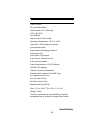
107
Appendix
User Defined Fleet Maps
Type I Programming Information
When a Type I system is designed, the address informa-
tion for all the ID’s is divided into 8 equal sized blocks,
numbered 0–7. When you program your scanner to track
a Type I system, you must select a size code for each of
these blocks. When you have assigned a size code to all
8 blocks, you’ll have defined the fleet map for the system
you are tracking. Each size code determines the number
of fleets, subfleets, and ID’s each block will have. For
example, a size code of S-4 has one fleet, which is
divided into 16 separate subfleets, and it has a total of
512 individual ID’s.
When a block is assigned a size code, the fleet or fleets
created within the block are assigned a Type I ID. The
way these ID’s display on your scanner depend on the
block number and the block’s size code. When a Type I
ID appears, the leftmost digit represents the block which
contains the ID.
The next three digits identify which fleet is active, and the
last digit(s) identifies the subfleet.
The details concerning how the size codes are selected
by a Type I System designer are highly dependent on the
specific needs of the system’s users. Some organizations
might want many subfleets with only a few radios each,
while another organization might want only a few sub-
fleets with many radios each. Your task is to program your
fleet map with the same size code assignments as the
trunked system. If you do this accurately, you’ll track all
the Fleet-Subfleet combinations used by the system. In
other words, you’ll hear complete communications while
monitoring a trunked system.
If you don’t already know the size codes used, you’ll have
to guess at them. But since you don’t have to figure out all
the blocks at once, this isn’t as hard as it seems. Select a
size code for a block, and then press Scan. Now listen to
the communications. If you decide you are receiving most


















